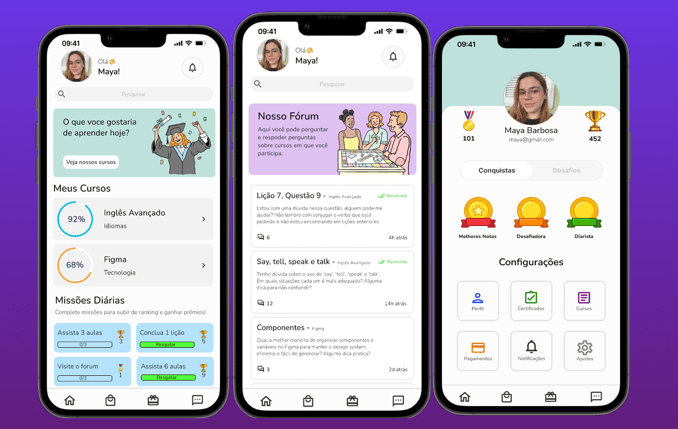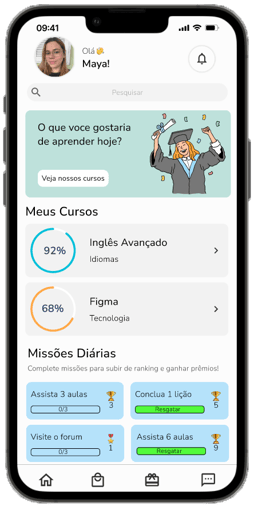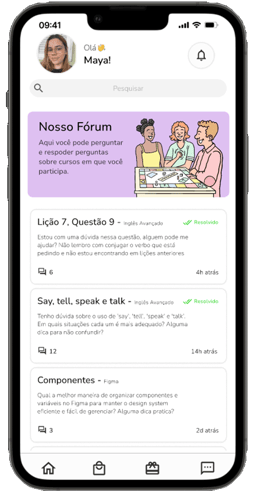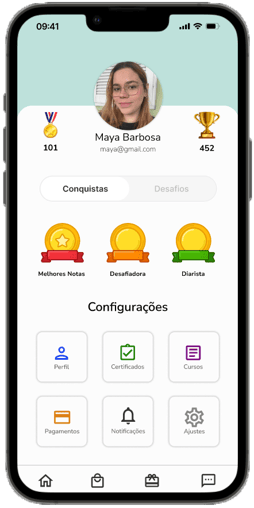Gamification in Education
I developed a gamification strategy for an e-learning platform to enhance student engagement and motivation. By implementing points, badges, and leaderboards, the initiative led to increased dedication, progress, and course completion rates.


1. Introduction
Distance education has grown significantly in recent years, driven by technological advancements and the need for flexibility in learning. However, one of the biggest challenges faced by students and educational institutions is the lack of engagement and motivation. Without a physically structured environment, many students struggle to maintain discipline, create an efficient routine, and complete online courses.
Gamification emerges as an innovative solution to this problem, applying game elements in the educational context to make learning more dynamic, engaging, and rewarding. Strategies such as points, rankings, challenges, and rewards are effective in encouraging commitment and persistence among students.
This case presents a UX approach for implementing gamification in a digital learning platform. The goal is to create a system that encourages continuous progress, rewards student effort, and provides greater value for recruiters and companies interested in identifying highly dedicated learners. Additionally, we explore the impacts of gamification on knowledge retention, skill development, and strengthening the academic community.
Below, we detail the project objectives, insights obtained from user research, the adopted gamification strategy, and the results after testing and iterations.
2. Objective
Our main objective is to develop an interactive experience for students that:
Increases engagement and retention in online courses.
Rewards relevant actions throughout the learning journey.
Demonstrates progress in a tangible way using game elements.
Encourages collaboration among students, promoting an active and participative community.
Highlights students' efforts in the job market by creating a recognition system for recruiters.
To achieve this goal, we will use user-centered research and design methodologies, combining qualitative and quantitative insights.
3. User Research
Methodology
To support our decisions, we conducted qualitative user research using a semi-structured interview methodology. Fixed questions were prepared for all interviewees, and depending on their responses, we delved deeper into the topic with additional questions. This allowed us to gain a richer understanding of the needs, challenges, and motivations of students, teachers, and recruiters.
Profiles Interviewed
To better understand the users' needs, we interviewed three main groups:
Students (the platform’s primary users)
Teachers (content creators and facilitators of learning)
Recruiters (potential employers of students)
Key Insights
From the interviews, we identified the following points:
Students
✅ Main challenges:
Lack of self-discipline and procrastination.
Difficulty maintaining focus and creating a routine.
Unclear sense of progress, demotivating continued learning.
✅ What motivates them?
Recognition for effort and progress.
Tangible rewards, such as certificates and financial benefits.
The opportunity to interact and learn from other students.
Teachers
✅ Main challenges:
Low student interaction in classes and forums.
Difficulty evaluating student engagement levels.
Lack of mechanisms to encourage continuous practice.
✅ Suggestions for engagement:
Create challenges and hands-on activities.
Provide personalized feedback.
Encourage active participation in forums and communities.
Recruiters
✅ Valued skills:
Consistency in learning and dedication.
Ability to apply acquired knowledge.
Involvement with the community and collaboration.
✅ How can gamification help?
Create relevant performance metrics for the job market.
Highlight the most committed students through rankings and unique certifications.
4. Gamification Strategy
Based on the insights gathered, we developed a gamification strategy using the following mechanisms:
Applied Mechanisms
🎯 Points: Earned by attending classes, completing challenges, and interacting in the forum.
🏅 Badges: Earned by achieving specific goals.
📊 Ranking: Stimulates healthy competition among students.
🚀 Progress Bars: Clear visualization of course progress.
🎁 Rewards: Points can be converted into real benefits.
📅 Intermediate Goals: Small objectives throughout the course.
🔥 Multiplicative Factors: Bonuses for students who study consistently.
5. Prototyping
Main Screens
📌 Home Screen: Overview of progress and upcoming challenges.
📌 Student Profile: Display of achievements, ranking, and learning history.
📌 Challenges Mechanism: Suggested activities and rewards.
📌 Forum and Community: Space for interaction and questions.
📌 Rewards Panel: Options for point conversion.
Design of Initial Screens (Home, Profile, Forum)






6. Testing and Iteration
Tests Conducted
🔍 Usability Test: Identifying navigation difficulties.
📢 Student Feedback: Opinions on the overall experience.
Iterations Made
Adjusted the point system to better value practice.
Improved the progress panel interface.
Added daily missions to encourage consistency.
7. Conclusion
The implementation of gamification resulted in increased student engagement. The use of points, badges, and rankings provided a more immersive experience, boosting motivation and course completion rates.
The next steps include refining the experience based on continuous feedback and exploring new ways to reward practical learning. Additionally, we plan to expand the recognition system so recruiters can easily identify the most dedicated and qualified students.
🚀 Gamification is not just fun — it's a powerful engine for learning and transformation!
